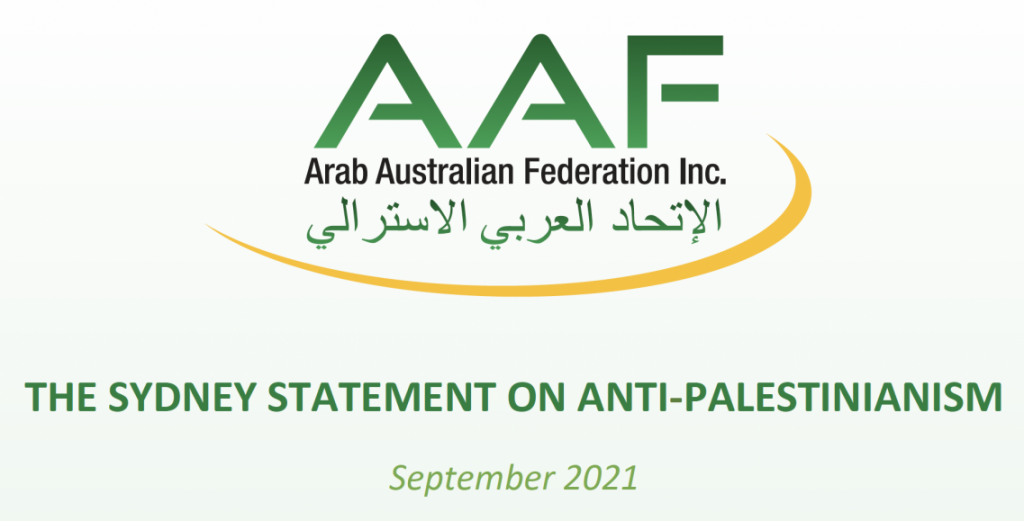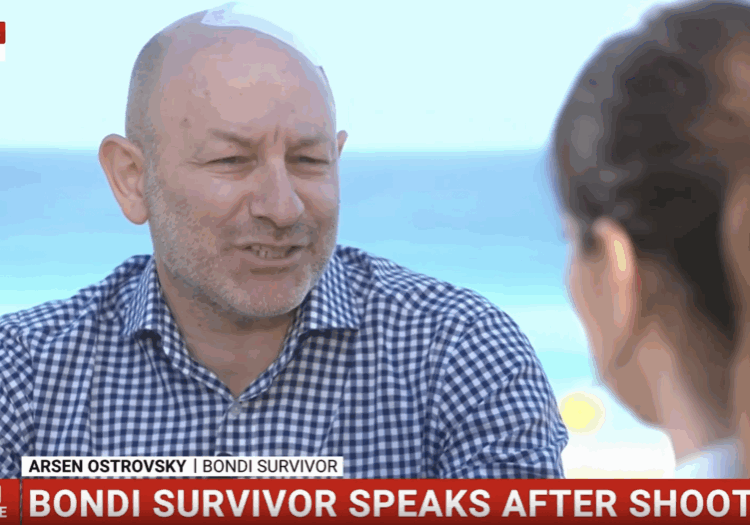FRESH AIR
The “Sydney Statement on anti-Palestinianism”: An Analysis
December 8, 2021 | Judy Maynard

A document called the “Sydney Statement on anti-Palestinianism” was released in September 2021 by the Arab Australian Federation (AAF).
AIJAC understands that this document was sent to many or all Members of Federal Parliament and also to at least some state MPs. It was also promoted by former academic and pro-Palestinian activist Stuart Rees on the website “Pearls and Irritations”, published by John Menadue, on Sept. 15.
It appears to have been written as a response or counter-weight to the International Holocaust Remembrance Alliance Working Definition of Antisemitism, which was officially “embraced” by the Federal Government in October, and is also supported by the ALP Opposition. Rees certainly promoted the statement as such, writing of it that “to hinder the rush to endorse the poorly conceived International Holocaust Remembrance Association (IHRA) definition of anti-Semitism, a statement of anti-Palestinianism is desperately needed.” As we will see below, the text of the statement itself also makes the connection to the IHRA definition pretty clear.
What follows is AIJAC’s analysis of the Sydney Statement on anti-Palestinianism.
Targeting the IHRA antisemitism definition
The statement asserts that anti-Palestinianism “refers to language and practices that directs (sic) discrimination, racism, hatred or violence against the Palestinian people.” Such “discrimination” is “reflected in Israel’s military occupation of Palestinian land, the containment of millions of Palestinians in refugee camps and the systematic attacks on the lives and property of people under occupation.”
It further states, “Accusations of Anti-Semitism should not be used to shield Israel from criticisms of its oppression of Palestinian people and its defiance of international law.”
As noted, this makes it clear that the “Sydney Statement” has been drafted as a response to the Working Definition of Antisemitism adopted by the IHRA in 2016, which has now been endorsed by 33 countries, including Australia, numerous other political entities such as regional/state and local governments, and a range of organisations.
The fact that the AAF thought it appropriate to draft a statement like this one on “anti-Palestinianism” in response to the IHRA definition is both odd and concerning.
The IHRA definition is straightforward and unobjectionable: “Antisemitism is a certain perception of Jews, which may be expressed as hatred toward Jews. Rhetorical and physical manifestations of antisemitism are directed toward Jewish or non-Jewish individuals and/or their property, toward Jewish community institutions and religious facilities.”
This is followed by a series of examples to guide IHRA and others seeking to combat antisemitism in their work. These include such familiar tropes as espousing myths about “a world Jewish conspiracy or of Jews controlling the media, economy, government or other societal institutions,” as well as “Denying the fact, scope, mechanisms (e.g. gas chambers) or intentionality of the genocide of the Jewish people at the hands of National Socialist Germany.”
While the cancer of antisemitism has been present for millennia, its outward manifestations often mutate to take new forms that reflect what is particularly reviled in any given generation. Today, for example, there are few worse insults than being called a racist. For many years, demonisation of Israel has been moving towards using such characterisations, which are often then extended to Jews as a whole, or at least, all Jews who support Israel’s right to exist, which is the overwhelming majority.
Thus, one of the illustrations accompanying the IHRA definition is “claiming that the existence of a State of Israel is a racist endeavor”, which, in effect denies the Jewish people, alone, a right to self-determination, by calling their quest for such self-determination uniquely racist. This example is one of a few in the IHRA definition that demonstrate how some claims about Israel can potentially, “taking into account the overall context,” be antisemitic.
Critics of Israel have zeroed in on mentions of such claims about Israel in the definition’s illustrative examples, claiming the IHRA definition creates a false equation between any criticism of Israel and antisemitism. This is false and disingenuous, with many critics of the IHRA definition studiously avoiding its explicit disclaimer that “criticism of Israel similar to that leveled against any other country cannot be regarded as antisemitic.”
In other words, while the IHRA definition does rightly point out that some claims about Israel can be used as a cover for antisemitism, it absolutely does not prohibit or dictate any views about how one should view Israel’s conflict with the Palestinians, the Israeli state’s policies with respect to that conflict, or any proposal for solutions to that conflict.
“Anti-Palestinianism”
The Sydney Statement authors apparently think a good response to the IHRA definition is to insist that a failure to fully adopt the Palestinian narrative in the Israeli-Palestinian conflict, and support all Palestinian demands in it, is racism against Palestinians.
More than this, they appear to effectively imply that if you do not agree that “the existence of a State of Israel is a racist endeavor” in contravention of the IHRA example, then you are an “anti-Palestinian” racist.
The statement’s claim that “anti-Palestinianism” should be elevated to a special new form of racism relies on a series of enunciated “principles”. These amount to little more than a list of Palestinian demands, many based on unreliable assertions, and dubious legal claims – denial of which is touted as a form of racism.
The Sydney Statement purports to find support for its position through the broad and opportunistic appropriation of international rights which it re-labels as Palestinian. Principle One states: “Anti-Palestinianism exists when Palestinian people are denied rights enshrined in the Universal Declaration of Human Rights and all other relevant instruments of international law including UN resolutions.”
Principle Four states: “As part of the international community, the Palestinian people have an inalienable right to membership of international organisations.” Throughout the document, the authors use such misstatements of legal principles and documents to cherry-pick imagined rights for Palestinians and deny similar rights to Israelis.
The Israeli perpetrators of this “discrimination” are described as violent oppressors motivated by feelings of racial superiority and malevolent intent. They are accused of “systematic attacks” on Palestinians, and of “blatant prejudice” against them.
Meanwhile an entirely self-serving narrative imagines Palestinians, who are “engaged in a peaceful pursuit of nationhood,” are stigmatised as terrorists or as “an inferior people”. Israelis are represented merely as “occupiers”, without any context provided for their existence in the land, other than a supposed desire to “dispossess”, “confine”, “evict, and “subjugate” Palestinians (Principle Five).
Principle Two declares that “The Palestinian people are entitled to their own state. A Palestinian State is consistent with international law, UN resolutions and over 30 years of international negotiations.”
Of course a Palestinian state is “consistent” with international law – which merely means there is no legal bar to its establishment if the normal criteria for statehood are fulfilled – but this claim that Palestinians are “entitled” to a state ignores history and the reasons they do not yet have one.
For instance, UN General Assembly Resolution 181 in 1947 called for an Arab state alongside a Jewish one, a plan the Jews embraced, – yet Palestinian leaders unfortunately rejected in favour of war, so as to deny Jewish self-determination.
This led to bloody war instead and what Palestinians call the Nakba, or catastrophe.
A Palestinian state was also consistent with Israel’s generous peace proposals of 2000, 2001 and 2008, all also rejected by the Palestinian leaders.
That the Palestinians should have their own state is not contentious, only the means of arriving at one. The statement puts up a number of similar straw men. Another is, “Palestinians who have committed to non-violent means to nationhood are entitled to all legitimate means of protest and advocacy”, which appears in Principle Three.
No one would dispute this – but what is legitimate? Given that the whole statement is clearly inspired by the IHRA definition of antisemitism, the inclusion of this phrase appears to imply that antisemitism can be part of “legitimate means of protest and advocacy.” It seems unlikely many people outside radical pro-Palestinian circles would agree.
Principle Three of the statement insists, “Palestinian leaders deserve respect and engagement not isolation and boycott” despite their refusal to engage in negotiations since 2014, and their stance against normalisation of relations with Israelis, and active encouragement of violence against Israeli civilians.
Principle Seven boldly declares, “Palestinians have the right to their history including their right to commemorate Nakba Day and this must never in any way be denied them.” Again, no one denies them this right (the statement later refers to Israeli laws which deny Israeli government funding for such commemorations, but this is hardly a denial of the right to have them.) The only point, it seems, of including such uncontested sentiments appears to be to set up another parallel with the IHRA Working Definition of Antisemitism, with respect, in this case, to its targeting of Holocaust denial.
Principle Six advocates for a Palestinian right of return to Israel – which is completely inconsistent with Israel’s continued existence as a homeland for the Jewish people.
All the “Examples of Anti-Palestinianism” given in the Sydney Statement following the “Principles” involve either alleged statements by Israeli leaders and commentators, or Israeli policies.
While some of the statements cited are genuinely deplorable, others are simply statements of opposition to Palestinian statehood, or promises to fight Palestinian terrorism.
Other supposed examples of “anti-Palestinianism” given include Israeli security measures necessitated by Palestinian terrorism (never mentioned in the statement of course), such as the “imposed permit regime, militarised check points, fixed and mobile roadblocks and Israel’s infamous separation barrier” in the West Bank.
Another example given is the Nation State law Israel passed in 2018, which says that “the right to self-determination in the state of Israel is unique to the Jewish people.”
While this law has been controversial, it is completely consistent with a two-state solution, and yet this document declares Israel’s self-description as a Jewish homeland to be racist “anti-Palestinianism”.
The statement contains numerous misstatements of fact, but then, accuracy is not the goal. Unlike the IHRA definition, which is the distillation of many years of international and expert deliberation, this document simply conflates less than full support for all aspects of the Palestinian political struggle with racism.
It is also a means of laying blame on Israel for all that has gone wrong for the Palestinians, as if the Palestinian leadership has exercised no agency throughout the past turbulent decades.
The Sydney Statement is also notable for what it does not contain. There is no mention in it of some genuine forms of racism Palestinians may suffer and which do have real parallels to points in the IHRA definition – such as blaming individual Palestinians for the policies of the Palestinian leadership or Hamas, or claiming all Palestinians are terrorists, or discrimination against Palestinians outside of the Israeli-Palestinian conflict.
Who wrote the Sydney Statement and why?
The Sydney Statement on anti-Palestinianism is the creation of the Arab Australian Federation (AAF), which describes itself as “a democratically constituted umbrella organisation… represent[ing], in unity of purpose, a growing number of Arab Australian associations and individual members of our community.”
The AAF has published a lengthy constitution which states that the “Founding members of the Association are the people and organisations present at the meeting of 19 September 2018… included in Appendix A.” Yet there is no Appendix A on the document on the website. This coyness extends to the rest of the website, where only a single individual is identified as an officer of the AAF, chairperson Eddie Zananiri. (An SBS Arabic radio interview on Nov. 5, 2021 claimed that Hassan Moussa is Secretary-General of the AAF, but there is no information about his role in the organisation on the AAF’s website or social media pages).
Zananiri was Vice-President of the General Union of Palestinian Students (GUPS), a part of the Palestine Liberation Organisation (PLO), at a time when the PLO was synonymous with terrorism and rejectionism. In May 1975, he and another GUPS official, Samir Cheikh, were at the centre of a series of violent protests in Australia when he was invited to visit by the head of the Australian of Union Students. During those protests, PLO supporters repeatedly attacked Jewish and pro-Israel students demonstrating against their visits, and several Jewish protesters were injured.
During the visit, Zananiri rejected a two-state solution and Israel’s continued existence, and condoned the use of violence as a means to achieve Palestinian aims.
He tried to immigrate to Australia following that visit on a fiancée visa after proposing to marry an Australian pro-Palestinian activist, but was denied a visa to do so by the Department of Immigration in the Fraser Government – in part because there were reportedly concerns he was seeking to move here to become the PLO representative in Australia.
According to the booklet The Palestinian Community in Australia (published by thePalestinian International Institute, based in Amman, Jordan), he finally emigrated to Australia in 1988 after having “had long and deep experience with the Union of Palestinian Students, an important affiliate of the PLO.”
Zananiri has remained a prominent Sydney-based Palestinian activist ever since, often speaking at pro-Palestinian events.
According to its website, the AAF “crafted” the Sydney Statement “in consultation with leading community figures and renowned advocates for Palestine from diverse backgrounds… in response to the incessant violations by Israel of the Palestinian people’s human, political, economic and national rights under international law, including their right to self-determination and nationhood.”
Note that the above statement is explicit that the purpose of the Statement is to condemn Israel’s alleged racist “violations” against Palestinians, not to provide a tool against racism Palestinians may suffer in Australia or other countries in which they live.
Conclusion
It is clear that, for the authors of the Sydney Statement, “Anti-Palestinianism” is simply a new gloss on the traditional Palestinian narrative of victimhood at the hands of a brutal oppressor, accompanied by a litany of traditional Palestinian demands.
Any sensible and knowledgeable person reviewing the statement should recognise it for what it is – and also note that it has nothing to with the battle against racism, much less the widely used IHRA Working Definition of Antisemitism, even though that is its target.
Tags: Antisemitism, Australia, IHRA definition, Israel, Palestinians
RELATED ARTICLES

The Government’s actions still fall short: Joel Burnie on FDD Morning Brief

“The writing was on the wall for a number of years”: Colin Rubenstein on Channel 7 Weekend Sunrise





















